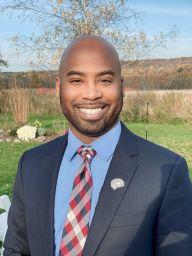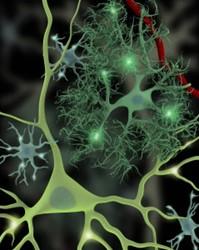
Nathan Anthony Smith, MS, Ph.D., AAAS Fellow
Associate Professor of Neuroscience
Del Monte Neuroscience Institute
Associate Dean of Equity and Inclusion, Research and Research Education
University of Rochester School of Medicine and Dentistry
The Smith Lab
Mentoring the Next Generation in Neuroscience
All it took was a gift from my cousin to spark my passion for neuroscience. In high school, she gave me the book, “Gifted Hands,” which is the autobiography of the neurosurgeon Dr. Ben Carson. Through his story, I became fascinated by the brain, inspiring my interest in neurosurgery. As an undergraduate at Xavier University, I majored in biology, but neuroscience remained at the forefront of my mind. My pre-med advisor, Dr. J.W. Carmichael, had a plan for success for all pre-med students and emphasized the importance of gaining research experience. He helped connect students to summer research programs at research-intensive institutions, and I was able to participate in research most summers with the intent of becoming a neurosurgeon.
My first exposure to neuroscience research was after my sophomore year at the University of Minnesota with Dr. Christopher Honda, where I examined methods of opioid administration to bypass its addictive properties. Dr. Honda’s mentorship was invaluable as a new undergraduate trainee. He laid out a tailored training plan throughout my 10-week program, guiding me through the research process from experimental design to animal handling. He was very personable, patient, and had exceptional teaching skills, which helped me feel welcomed into the research space. The next summer, I joined Dr. Jonathan Mink's lab at the University of Rochester, where I studied Tourette syndrome using non-human primates. As I neared graduation, Dr. Mink suggested exploring other research fields to make sure neuroscience is the end all be all. Following his advice, I became a research technician in Dr. Hicham Drissi's orthopedics lab after graduation. During this time, I co-authored my very first paper as the first author in orthopedics. This experience not only confirmed my passion for research but also solidified my interest in neuroscience. During this time, I also realized that my true calling was not medicine but rather research, where I could make an impact on many lives by studying complex brain disorders.
For my Ph.D., I attended the University of Rochester and joined the lab of Dr. Maiken Nedergaard, researching the functional role of astrocytes in the brain. Dr. Nedergaard’s enthusiasm for her research and unique mentoring style really resonated with me. I was the only Black graduate student in my program, and I encountered many challenges during my graduate training, including skepticism and bias. There is a lot of pressure for underrepresented scientists not to fail. Sometimes, it can feel like you are carrying the weight of your entire community because we are often not judged as individuals but as a monolithic group; if one of us fails, we all fail. I couldn’t afford to let anyone’s negativity toward me stop my momentum as a scientist. Dr. Nedergaard provided guidance on how to navigate these challenging situations and prepared me to be an independent and resilient scientist. She partnered me with postdocs in the lab to train me to be an expert in several different techniques, she taught me to write grants so I could receive my own funding, and she taught me to advocate for myself. I received a NINDS F31 award as a graduate student, which helped support my research and gave me the dedicated time to focus on my research training.
For my postdoc, I trained at two different institutions, first, at the University of Utah with Drs. John White and Karen Wilcox, and then, at Children’s National Hospital with Dr. Judy Liu. Both experiences allowed me to hone my research skills, grow as a mentor, and prepare for my transition to a faculty position. The highlight of my time in Utah was mentoring students in the lab whose interests ranged from neuroscience to engineering and even mathematics. This is where I learned to appreciate the need to train the next generation of scientists. I was then recruited to Children’s National by Dr. Vittorio Gallo, where I conducted my postdoc research under a NIH T32 grant before transitioning to an independent faculty position. The T32 funding provided me protected time to develop my research program and a mentoring committee and support network to ensure I was making progress in my career.
During this time, I also joined two NINDS-funded R25 programs, the BRAINS and MINDS programs, which introduced me to mentors and colleagues outside of my home institution. These relationships not only allowed me to build my research program but also gave me a source for valuable career advice and professional development. Communities like these are important for underrepresented scientists because they provide a platform for connecting and sharing stories, which affirm their hardships and challenging experiences. Together, we can move away from continuing a toxic cycle and promote light to inspire other underrepresented scientists to pursue academic research. These connections also allow you to have access to the hidden curriculum of succeeding in academia.
NIH R25 programs and groups like the National Mentoring Research Network, taught me how to navigate academia and write grants. Participating in the NIH-sponsored grant writing workshop also helped me get the trifecta of government funding, my NINDS Faculty K01, and grants from the National Science Foundation and the Department of Defense. Receiving the Diversity Faculty K01 from NINDS as an assistant professor marked a significant turning point in my career. The award underscored the importance of persistence and helped me overcome my imposter syndrome by validating the merits of my research. I often stress to my trainees that diversity is not a bad word. Some trainees think that grants to promote diversity are “less than” other awards, but they are not! These awards are just as competitive and deserve respect as they are reviewed in the same rigorous manner as non-diversity grants. Diversity grants are not a sign of weakness and should be viewed as an opportunity rather than a concession. Research needs diversity – diversity in thought, geographic regions, race, gender, and inclusion of individuals with disabilities— We need diverse groups to lend their unique perspectives to research, push boundaries, and promote innovation.
In 2022, I was recruited back to the University of Rochester as an associate professor of neuroscience and associate dean of equity and inclusion in research and research education. I could not pass up the opportunity to change the research culture at the ground level as an associate dean while continuing my neuroscience research. With this leadership position, I want to help as many researchers as I can, and I especially want to bring relief to individuals who are experiencing hardships. I want them to know I am in their corner, supporting them, trying to find a solution, and am offering to fight for them as a mentor regardless of their situation.
It's important to remember that being a successful scientist goes beyond having technical expertise; it requires empathy, active listening, and an appreciation for a diversity of perspectives. Also, as a PI, you must create an environment that allows your lab members to be their authentic selves. Personal experiences will always intersect with our professional endeavors, it’s impossible to separate the two. You should never dim the light of the next generation because that will hinder progress and stifle innovation. Your mentoring extends beyond your lab; you are shaping the next generation and your legacy. Help foster a community where everyone’s contributions are valued – it’s not just about you, but everyone in your group. Also, keep in mind that positivity and resilience in research go a long way. Setbacks will always be part of the scientific process, but approaching your trainees with a positive and respectful attitude and meeting them where they are will nurture their growth and yield tremendous results.
My Current Research

Projects in my laboratory focus on “NeuroGlial” interactions. My research explores the understudied and novel mechanisms by which neuromodulators, such as norepinephrine, mediate the interactions between neurons, astrocytes, and microglia in normal and disease states. By studying how neuromodulators mediate the unique interactions between these three cell types, we will elucidate their coordinated functions in the normal, healthy brain and how disruptions of neuronal-glial crosstalk will contribute to disease processes such as ADHD, epilepsy, and acute insulin resistance. To that end, we hope these studies will provide valuable insight into the role of glia in pathophysiology, aiming to identify pathways that can be manipulated to alter disease progression in the central nervous system. To accomplish these goals, we employ a combination of transgenic animals, electrophysiology, pharmacology, behavioral assays, and 2-Photon Ca2+ microscopy in acute slices and awake-behaving animals.
